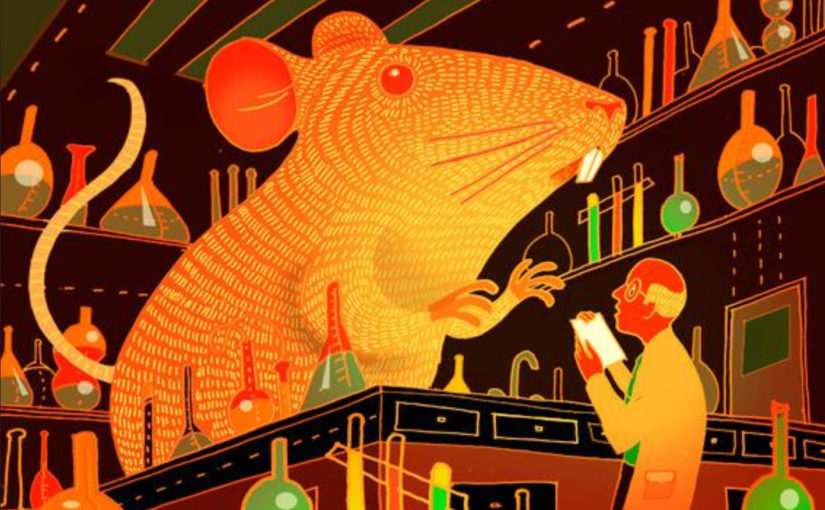Well, it's gonna be the year of the rat in a few days. What would be more appropriate than to discuss RAT lifestyle in urban centers?
On July 9th, 1968, eight white mice were placed into a strange box at the National Institute of Health in Bethesda, Maryland.
Maybe “box” isn’t the right word for it; the space was more like a room, known as “Universe 25”, and it was large. It was about the size of a small storage unit.
The mice themselves were bright and healthy, hand-picked from the institute’s breeding stock.
They were given the run of the place, which had everything they might need: food, water, climate control, hundreds of nesting boxes to choose from, and a lush floor of shredded paper and ground corn cob. It was a mouse paradise. It was perfect in every way.
Of course, this is a far cry from a wild mouse’s life. There were no predators, no cats, no traps, no long winters. It was even better than your average lab mouse’s life. Which, of course, is constantly interrupted by white-coated humans with scalpels or syringes.
The residents of “Universe 25” were mostly left alone, save for one man who would peer at them from above, and his team of similarly interested assistants. They must have thought they were the luckiest mice in the world.
They couldn’t have known the truth: that within a few years, they and their descendants would all be dead.
John Bumpass Calhoun
The man who played mouse-God and came up with this doomed universe was named John Bumpass Calhoun.
As Edmund Ramsden and Jon Adams detail in a paper, “Escaping the Laboratory: The Rodent Experiments of John B. Calhoun & Their Cultural Influence,” Calhoun spent his childhood traipsing around Tennessee, chasing toads, collecting turtles, and banding birds. These adventures eventually led him to a doctorate in biology, and then a job in Baltimore, where he was tasked with studying the habits of Norway rats, one of the city’s chief pests.
Conditions of the utopia.
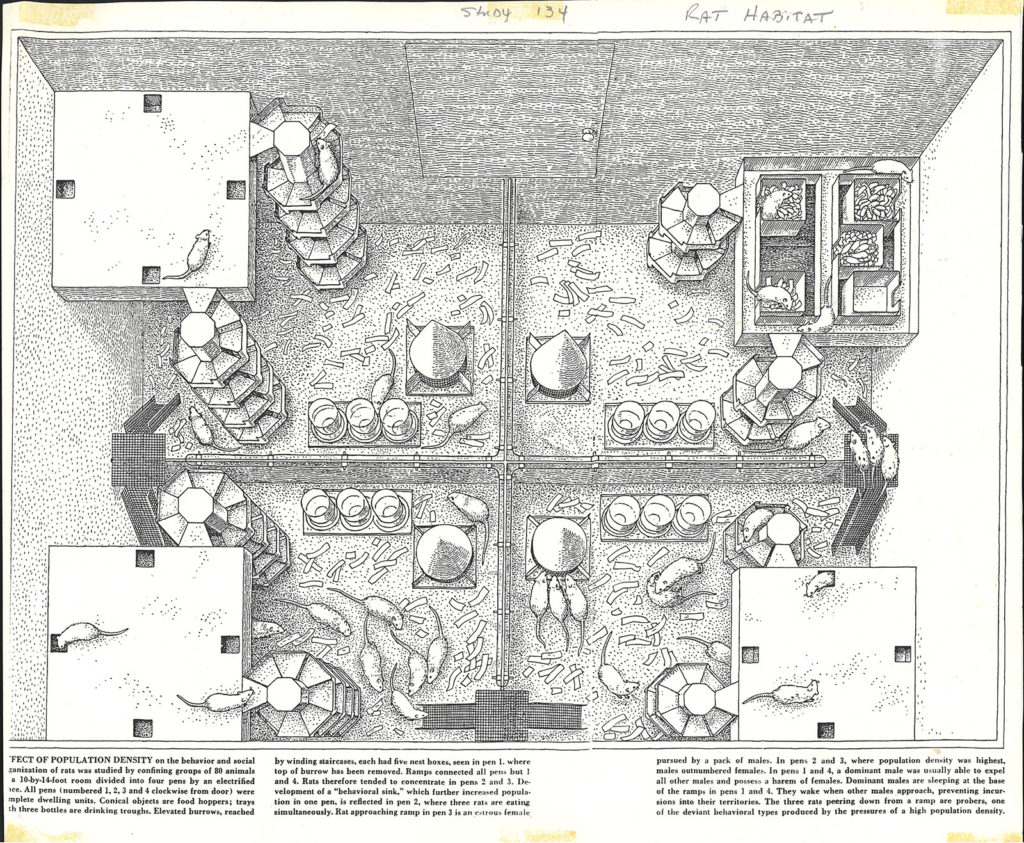
- No shortage of food, water and nesting material.
- No predators.
- Limited opportunities for transmissible disease.
- The only adversity: space limitation – the size of the habitat was predicted to host 3840 mice.
The first utopia.
In 1947, to keep a close eye on his charges, Calhoun constructed a quarter-acre “rat city” behind his house, and filled it with breeding pairs. He expected to be able to house 5,000 rats there, but over the two years he observed the city, the population never exceeded 150. At that point, the rats became too stressed to reproduce. They started acting weirdly, rolling dirt into balls rather than digging normal tunnels. They hissed and fought.
This fascinated Calhoun—if the rats had everything they needed, what was keeping them from overrunning his little city, just as they had all of Baltimore? Why couldn’t they thrive in a rodent utopia?
The subsequent utopias.
Intrigued, Calhoun built another, slightly bigger rat metropolis—this time in a barn, with ramps connecting several different rooms.
Then he redesigned the structure, and built another.
Then taking the lessons learned, he built another.
And another.
Then he built another and another, hopping between patrons that supported his research, and framing his work in terms of population: How many individuals could a rodent city hold without losing its collective mind?
The 1954 rodent utopia.
By 1954, he was working under the auspices of the National Institute of Mental Health, which gave him whole rooms to build his rodentopias. Some of these featured rats, while others focused on mice instead.
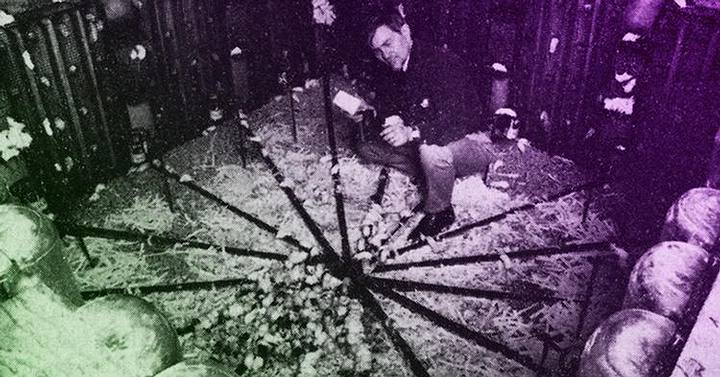
Like a rodent real estate developer, he incorporated ever-better amenities: climbable walls, food hoppers that could serve two dozen customers at once, lodging he described as “walk-up one-room apartments.”
A Video records of his experiments show Calhoun with a pleased smile and a pipe in his mouth, color-coded mice scurrying over his boots.
Still, at a certain point, each of these paradises collapsed.
“There could be no escape from the behavioral consequences of rising population density,” -Calhoun wrote in an early paper.
The story of the 1968 “Universe 25” collapse.
It was a pattern that would not collapse. No matter how hard he tried. The final test confirmed this. Universe 25—the biggest, best mousetopia of all, built after a quarter century of research—failed to break this pattern.
In July 1968 four pairs of mice were introduced into the Utopian universe. The universe was a 9-foot (2.7 m) square metal pen with 54-inch-high (1.4 m) sides. Each side had four groups of four vertical, wire mesh "tunnels". The "tunnels" gave access to nesting boxes, food hoppers, and water dispensers. There was no shortage of food or water or nesting material. There were no predators. The only adversity was the limit on space. Initially the population grew rapidly, doubling every 55 days. The population reached 620 by day 315, after which the population growth dropped markedly. The last surviving birth was on day 600. This period between day 315 and day 600 saw a breakdown in social structure and in normal social behavior. Among the aberrations in behavior were the following: - expulsion of young before weaning was complete, - wounding of young, - inability of dominant males to maintain the defense of their territory and females, - aggressive behavior of females, - passivity of non-dominant males with increased attacks on each other which were not defended against. After day 600, the social breakdown continued and the population declined toward extinction. During this period females ceased to reproduce. Their male counterparts withdrew completely, never engaging in courtship or fighting. They ate, drank, slept, and groomed themselves – all solitary pursuits. Sleek, healthy coats and an absence of scars characterized these males. They were named "the beautiful ones". - Description in Wikipedia [2014.05.25]
In late October, the first litter of mouse pups was born.
After that, the population doubled every two months—20 mice, then 40, then 80. The babies grew up and had babies of their own. Families became dynasties, carving out and holding down the best in-cage real estate.
By August of 1969, the population numbered 620.
Then, as always, things took a turn. Such rapid growth put too much pressure on the mouse way of life.
As new generations reached adulthood, many couldn’t find mates, or places in the social order—the mouse equivalent of a spouse and a job. Spinster females retreated to high-up nesting boxes, where they lived alone, far from the family neighborhoods. Washed-up males gathered in the center of the Universe, near the food, where they fretted, languished, and attacked each other. Meanwhile, overextended mouse moms and dads began moving nests constantly to avoid their unsavory neighbors. They also took their stress out on their babies, kicking them out of the nest too early, or even losing them during moves.
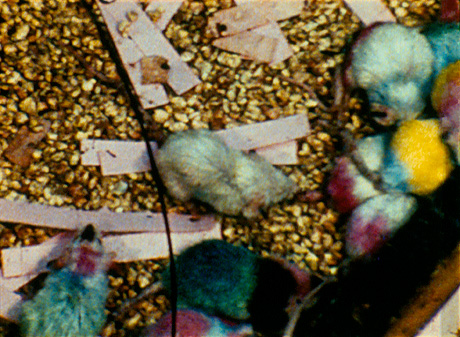
Population growth slowed way down again. Most of the adolescent mice retreated even further from societal expectations, spending all their time eating, drinking, sleeping and grooming, and refusing to fight or to even attempt to mate.
These individuals were forever changed—when Calhoun’s colleague attempted to transplant some of them to more normal situations, they didn’t remember how to do anything.
In May of 1970, just under 2 years into the study, the last baby was born, and the population entered a swan dive of perpetual senescence. It’s unclear exactly when the last resident of Universe 25 perished, but it was probably sometime in 1973.
Paradise couldn’t even last half a decade.
The periods or cycles…
In a unique experiment that took years to complete, Doctor Calhoun used white mice to study population growth and its effects on individual behavior.
In this sixteen cell mouse habitat, utopian conditions of nutrition, comfort and housing were provided for the potential population of over three thousand mice. […] Factors which normally control population growth such as predation by owls and cats were eliminated. Transmissible disease were also reduced. In effect, the mouse universe simulated the present situation of the continually expanding population of humans.
To see how Dr Calhoun’s mouse universe grew, we use the population graph.
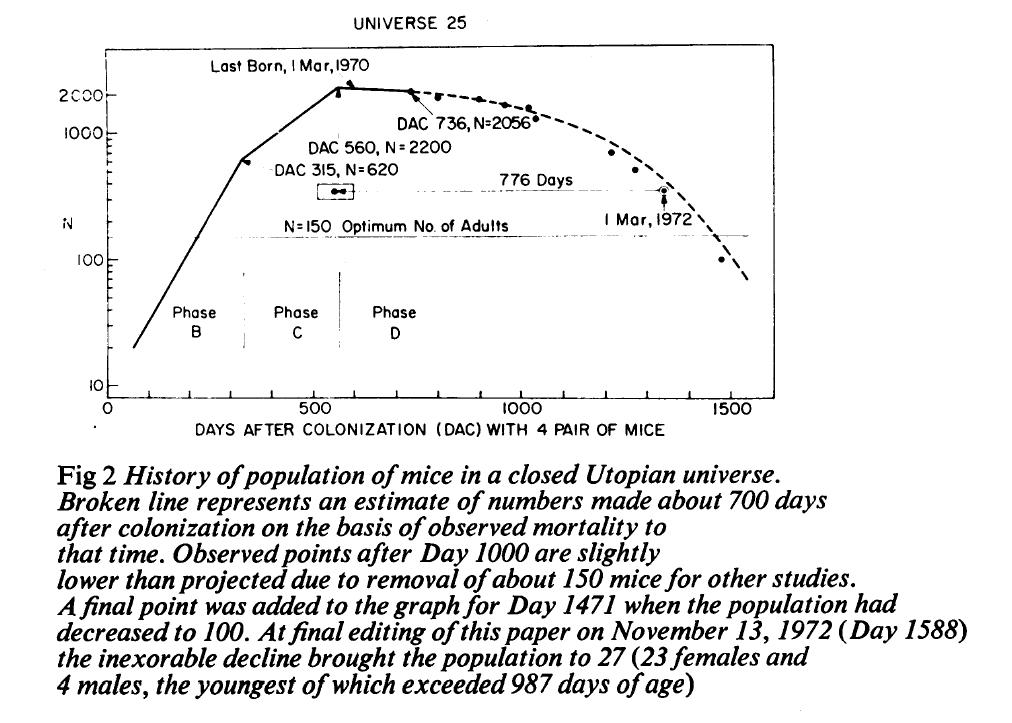
Phase A – The phase of social adjustment (strive period)
Within the first one hundred days, the mice went through the period Dr Calhoun called, “strive”. This was the period of adjustment. Territories were established and nests were made.
- (1) Considerable social turmoil among the 8 mice until they became adjusted to each other and to their expanded surroundings.
- (2) Territories were established and nests were made.
Phase B – The phase of most rapid growth (exploit period)
The next period lasted about two hundred and fifty days. The population of the mice doubled every sixty days. This was called the “exploit” period. The use of resources become unequal. Although each living unit was identical in structure and opportunities, more food and water was consumed in some areas.
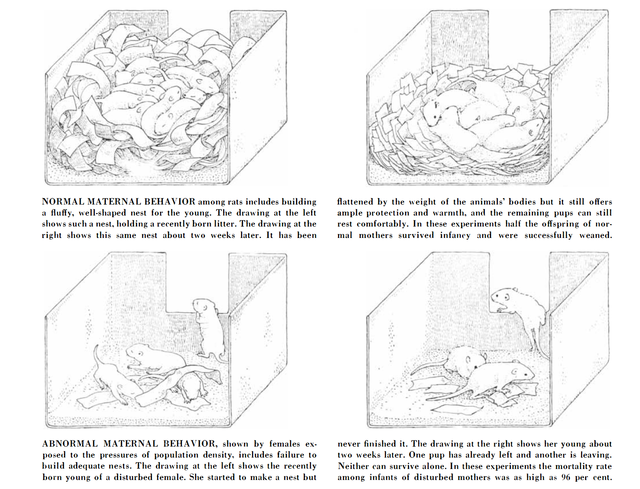
As the population increased, most mice associated eating and drinking with the presence of others. And crowding developed in certain units.
- (1) Population doubling time is about 55 days
- (1) Social organization established – frequency of litters proportional to social dominance
- (1) The births tended to be concentrated in some sets of nest boxes (dominant males), while others (non-dominant males – withdrawn males = WM) had few or none.
- (2) Although each living unit was identical in structure and opportunities, more food and water was consumed in certain areas. As the population increased, most mice associated eating and drinking with the presence of others. And crowding developed in certain units.
- (1) At the end of this phase there were 3 times as many socially immature mice as there were socially established older ones.
Phase C – The stagnation phase (equilibrium period)
The third period, consisting of three hundred days, found the population of mice leveling off. This was called the “equilibrium” period. Dr Calhoun noticed that the newer generations of young were inhibited, since most space was already socially defined.
At this time, some unusual behavior become noticeable.
Violence become prevalent. Excess males strived for acceptance, were rejected and withdrew. Huddling together, they would exhibit brief flurries of violence amongst themselves. The effects of violence became increasingly visible.

Certain individuals became targets of repeated attacks. These individuals would have badly chewed and scarred tails.
But the trajectory of rat utopia soon sobered Calhoun. The eager rodents did not seem capable of regulating their population size in the long-term. As they reproduced and the pens overflowed, Calhoun noted that male rates became aggressive, moving in gangs and attacking females and young. Some became exclusively homosexual. Female rats, meanwhile, abandoned their infants. The crowded mice had lost the ability to coexist. One of Calhoun’s assistants renamed the “rat utopia” “rodent hell.” -Space Cadets and Rat Utopias
Other young mice growing into adulthood exhibited an even different type of behavior. Dr Calhoun called these individuals “the beautiful ones”. Their time was devoted solely to grooming, eating and sleeping. They never involved themselves with others, engaged in sex, nor would they fight. All appeared as a beautiful exhibit of the species with keen, alert eyes and a healthy well-kept body. These mice, however, could not cope with unusual stimuli.
Though they looked inquisitive they were, in fact, very stupid.
All of this, however, led to a drop in mating, and the birthrate soon fell to a third of its former level. A social imbalance also took place among the mice:
- One-third emerged as socially dominant.
- The other two-thirds turned out less socially adept than their forbearers.
- As bonding skills diminished among the mice, Universe 25 went into a slow but irreversible decline.
By Day 315, behavior disparities between males of high and low status became more pronounced. Those at the bottom of the pecking order found themselves spurned from females and withdrew from mating altogether. Having no roles to fulfill within the society of mice, these outcast males wandered apart from the larger groups to eat and sleep alone — and sometimes fight among one another.
The alpha males, by contrast, became more aggressive and pugnacious, often launching into violence with no clear provocation or motive. At times, these males would roam around and indiscriminately rape other mice, regardless of gender.
Meanwhile, the beta males — those ranked between the aggressive alphas and outcast omegas — grew timid and inert, and often wound up being the passive recipients of violence. In several instances, bloodbaths ended with a cannibalistic feast for the victors.
- (1) Population doubling time is about 145 days
- (1) The male ability to defend territory declines
- (1) The nursing females become aggressive, essentially taking over the role of the territorial males. This aggression generalized to their own young who were attacked, wounded, and forced to leave home several days before normal weaning.
- (2) At this time, some unusual behavior became noticeable. Violence became prevalent. Excess males strived for acceptance, were rejected and withdrew. Social disorder became visible – a WM would attack a passive WM, who in turn would attack another WM. Certain individuals became targets of repeated attacks. These individuals would have badly chewed and scarred tails.
- (4) Socially withdrawn male 29 makes a pan-sexual approach to male 16 who he recently saw attacked. Note how one assumes the female role. Males exhibit sexual behavior towards other males; you have rat homosexuality. They begin mounting the young.
- (1) Incidence of conception decline and resorption of fetuses increases and dissolution of maternal behavior is observed. This lead to non-reproducing females.
- (1) By midway in phase C, essentially all young were prematurely rejected by their mothers. They started independent life without having developed adequate effective bonds.
- (1) Considering that there were 256 nest retreat sites in the 16 cells, one would not expect shelter to be a limiting factor until the population exceeded 3840. Due to the tendency of many animals to choose to crowd together in numbers in excess of 15 per nest site, at the peak population size of 2200 mice, 20% of all nest sites were usually unoccupied. Thus, there were always opportunities for females to select an unoccupied space for rearing young if they so chose.
- (1) Social disorder – a WM would attack a passive WM, who in turn would attack another
Phase D – The death phase (die period)
With male mice abandoning their traditional roles in Universe 25, the females were left to fend for their nests. Consequently, many females adopted more aggressive forms of behavior, which would sometimes spill over into violence toward their young.
Others would refrain from motherly duties altogether, banishing their unraised litters and withdrawing from further mating, resulting in serious consequences:
- In some compartments, the infant mortality rate topped 90 percent.
- Calhoun named this the “stagnation phase,” alternately known as the “equilibrium period.”
- He attributed the overly aggressive and passive behavioral patterns to the breakdown of social roles and rampant over-clustering.
Dr Calhoun called the last period the “die” phase, leading the population into extinction. Although the mouse utopia could house 3000, the population began to decline at 2200.
By the 560th day, the population increase had ceased altogether as the mortality rate hovered at 100 percent. This marked the start of the “death phase” — aka the “die period” — in which the rodent utopia slid toward extinction. Amidst the violence, hostility and lack of mating, a younger generation of mice reached maturity, having never been exposed to examples of normal, healthy relations. With no concept of mating, parenting or marking territory, this generation of mice spent all of their waking hours eating, drinking and grooming themselves.
In reference to their perfected, unruffled appearances, Calhoun called these mice the “beautiful ones.” Living in seclusion from the other mice, they were spared the violence and conflict that waged in the crowded areas, yet made no social contributions.
According to Calhoun, the death phase consisted of two stages: the “first death” and “second death.” The former was characterized by the loss of purpose in life beyond mere existence — no desire to mate, raise young or establish a role within society. This first death was represented by the lackadaisical lives of the beautiful ones, whereas the second death was marked by the literal end of life and the extinction of Universe 25.
- (1) Population increase abruptly ceased on day 560 after colonization.
- (1) Incidence of pregnancies decline very rapidly with no young surviving.
- (1) The last conception took place about day 920
- (1) Male counterparts to non-reproducing females were named the “beautiful ones”. They never engaged in sexual approaches toward females, and they never engaged in fighting. Their behavioral repertoire became largely confined to eating, drinking, sleeping and grooming.
- (1) The capacity for reproduction terminated.
- (3) The last thousand animals born never learned to develop the social behaviors, they never learned to be aggressive, which is necessary in defense of home sites; not engaging in any stressful activity, and only paying attention to themselves, they groomed themselves well so they looked like very fine specimens.
- (2) Other young mice growing into adulthood exhibited an even different type of behaviour. Dr Calhoun called these individuals “the beautiful ones”. Their time was devoted solely to grooming, eating and sleeping. They never involved themselves with others, engaged in sex, nor would they fight. All appeared as a beautiful exhibit of the species with keen, alert eyes and a healthy well-kept body. These mice, however, could not cope with unusual stimuli. Though they looked inquisitive they were, in fact, very stupid.
In the shift from the equilibrium to the die phase, each animal became less aware of associates, despite all animals being pushed closer together. Dr Calhoun concluded that the mice could not effectively deal with the repeated contact of so many individuals. The evidence of violence increased to the point where most individuals had had their tails bitten to some degree.
Gradually, the mice that refused to mate or engage in society came to outnumber those that formed gangs, raped and plundered, and fed off their own. The last known conception in Universe 25 occurred on Day 920, at which point the population was capped at 2,200, well short of the enclosure’s 3,000 capacity.
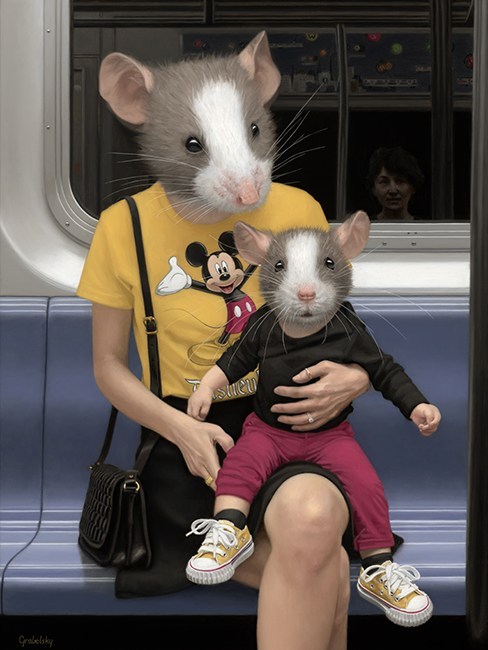
An endless supply of food, water and other resources were still there for the mice, but it didn’t matter. The behavior sink had set in, and there was no stopping Universe 25 from careening to its self-made demise. Soon enough, there was not a single living mouse left in the enclosure..
The results of the study were published.
Calhoun saw in his rats the decline of future society, evidence that inner city crowding led to rioting, crime, malaise, and political radicalism: the obsessions of postwar American academics. He wrote up his results in a Scientific American article that he titled “Population Density and Social Pathology.” The article became one of the most widely-cited papers in psychology. Like Pavlov’s dogs and Skinner’s pigeons, Calhoun’s rats became exemplars for human behavior. His experiments suggested a density beyond which rat society disintegrated, and—to Calhoun and his colleagues, at least—the parallels with human society were clear. - Space Cadets and Rat Utopias
In 1973, Calhoun published his Universe 25 research as “Death Squared: The Explosive Growth and Demise of a Mouse Population.” It is, to put it lightly, an intense academic reading experience.
He quotes liberally from the Book of Revelation, italicizing certain words for emphasis (e.g. “to kill with the sword and with famine and with pestilence and by wild beasts”).
He gave his claimed discoveries catchy names—the mice who forgot how to mate were “the beautiful ones”’ rats who crowded around water bottles were “social drinkers”; the overall societal breakdown was the “behavioral sink.” In other words, it was exactly the kind of diction you’d expect from someone who spent his entire life perfecting the art of the mouse dystopia.
Most frightening are the parallels he draws between rodent and human society. “I shall largely speak of mice,” he begins, “but my thoughts are on man.”
Both species, he explains, are vulnerable to two types of death—that of the spirit and that of the body. Even though he had removed physical threats, doing so had forced the residents of Universe 25 into a spiritually unhealthy situation, full of crowding, over-stimulation, and contact with various mouse strangers.
To a society experiencing the rapid growth of cities—and reacting, in various ways, quite poorly—this story seemed familiar.
Senators brought it up in meetings. It showed up in science fiction and comic books. Even Tom Wolfe, never lost for description, used Calhounian terms to describe New York City, calling all of Gotham a “behavioral sink.”
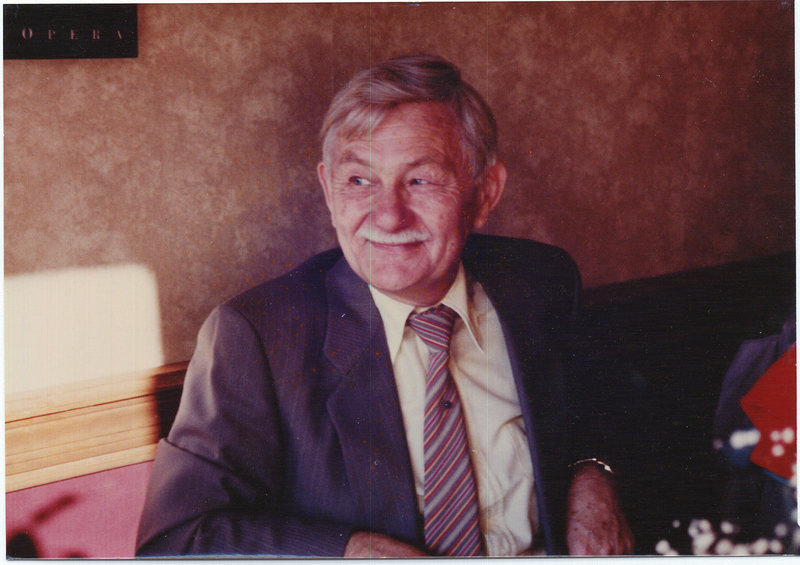
Trying to discover solutions.
Convinced that he had found a real problem, Calhoun quickly began using his mouse models to try and fix it.
If mice and humans weren’t afforded enough physical space, he thought, perhaps they could make up for it with conceptual space—creativity, artistry, and the type of community not built around social hierarchies.
His later Universes were designed to be spiritually as well as physically utopic, with rodent interactions carefully controlled to maximize happiness (he was particularly fascinated by some early rats who had created an innovative form of tunneling, where they rolled dirt into balls).
He extrapolated this, too, to human concerns, becoming an early supporter of environmental design and H.G. Wells’s hypothetical “World Brain,” an international information network that was a clear precursor to the internet.
Failed Salvage Attempt and Concluding Observations
Before the rodent utopia imploded entirely, Calhoun removed some of the beautiful ones to see whether they would live more productive lives if released into a new society, free of social strife and carnage.
Placing these mice in a fresh setting with few pre-existing residents — a scenario similar to that which greeted the initial pairs placed in Universe 25 — he expected the beautiful ones to awake from their asocial haze and answer nature’s call to populate the barren environment.

However, the relocated mice showed no signs of change from their earlier behavioral patterns. Refusing to mate or even interact among their new peers, the reclusive mice eventually died of natural causes, and the fledgling society folded without a single new birth.
In Calhoun’s view, the rise and fall of Universe 25 proved five basic points about mice, as well as humans:
- The mouse is a simple creature, but it must develop the skills for courtship, child-rearing, territorial defense and personal role fulfillment on the domestic and communal front. If such skills fail to develop, the individual will neither reproduce nor find a productive role within society.
- As with mice, all species will grow older and gradually die out. There is nothing to suggest human society isn’t prone to the same developments that led to the demise of Universe 25.
- If the number of qualified individuals exceeds the number of openings in society, chaos and alienation will be the inevitable outcomes.
- Individuals raised under the latter conditions will lack any relation to the real world. Physiological fulfillment will be their only drive in life.
- Just as mice thrive on a set of complex behaviors, the concern for others developed in post-industrial human skills and understandings is vital to man’s continuance as a species. The loss of these attributes within a civilization could lead to its collapse.
The public reaction.
But the public held on hard to his earlier work—as Ramsden and Adams put it, “everyone want[ed] to hear the diagnosis, no one want[ed] to hear the cure.”
Gradually, Calhoun lost attention, standing, and funding.
In 1986, he was forced to retire from the National Institute of Mental Health. Nine years later, he died.
His influence
There was one person who paid attention to his more optimistic experiments, a writer named Robert C. O’Brien.
In the late ’60s, O’Brien allegedly visited Calhoun’s lab, met the man trying to build a true and creative rodent paradise, and took note of the Frisbee on the door, the scientists’ own attempt “to help when things got too stressful,” as Calhoun put it.
Soon after, O’Brien wrote Ms. Frisby and the Rats of NIMH—a story about rats who, having escaped from a lab full of blundering humans, attempt to build their own utopia.
Next time, maybe we should put the rats in charge.
My story.
I knew about this study from the 1970’s when I was a boy. My father had a “Year in Review” series of books that accompanied the Encyclopedia Britannia collection that he had acquired in the 1960’s. These volumes would come to our door, and would be jam-packed with information and trivia of the year previous.
I would sit on the Lazy-boy chair and go through these big massive volumes and read the articles there. As such, I too, was influenced by this study.
I even brought it up for discussion in my classroom. But no one cared. They were too interested with “Johnathan Livingston Seagull” and the television cartoon special about a boy and his dog (which brought forth the hit song “Me and my arrow“.) The rest of my classmates were too worried about Climate Cooling and the coming great freeze to worry about the implications of this study.
Years passed.
Then I read an article that rewoke this narrative.
The Article that re-woke and rekindled my interest in this study.
Then I read this article titled “Article – The Doomed Mouse Utopia That Inspired the ‘Rats of NIMH’” which was posted on January 8, 2020.
The author comments…
Give a buncha rodents all the food, bedding, water, and stress-free living you can give them and they should breed like..well..rats. And have a population boom, right? Maybe not.
Such rapid growth put too much pressure on the mouse way of life. As new generations reached adulthood, many couldn’t find mates, or places in the social order—the mouse equivalent of a spouse and a job. Spinster females retreated to high-up nesting boxes, where they lived alone, far from the family neighborhoods. Washed-up males gathered in the center of the Universe, near the food, where they fretted, languished, and attacked each other. Meanwhile, overextended mouse moms and dads began moving nests constantly to avoid their unsavory neighbors. They also took their stress out on their babies, kicking them out of the nest too early, or even losing them during moves.
Some fascinating parallels to be had in just that one paragraph. To quote Judge Dredd “You put that many rats in one cage and something’s gonna happen.” The apparent message is that mammals ain’t cut out for being put into large metropolises. Even when you give them all the welfare food and shelter they want, they’ll still go bad. But, men are not rodents. Yet look at any major city and you’ll see that the segments of the population that have everything handed to them seem to be the most troubled and troublesome. Moral of the story? Stay out of enormous cities. Having just returned from a week in one of the biggest i can tell you with utter sincerity that nothing reinvigorated my mind and spirit more than being able to have room to stretch both physically and metaphorically. Away from the restricting confines of mandatory recycling, absurd gun laws, high sales taxes, etc, I felt I could breathe easier again and feel in control of my life. Big cities, in my experience, are superior in providing only three things: money, women, and food. High paying jobs, endless varieties of women, and a dizzying array of types of food… ...that's about all I can recommend for the big cities. But what do I get out of smaller venues, such as where I live? Relatively high levels of freedom, or, at least, qualities that I equate with freedom.
Men or mice…put too many in one place and bad stuff happens. Don’t be there.
Conclusions by “experts”
All conclusions drawn by socialist (& state) scientists constantly connect extinction with overpopulation:
The conclusions drawn from this experiment were that when all available space is taken and all social roles filled, competition and the stresses experienced by the individuals will result in a total breakdown in complex social behaviors, ultimately resulting in the demise of the population. - Wikipedia 2014.05.25
Overpopulation = Extinction
However in the Calhoun’s papers there are clear evidences that this is not so:
- All of the available space was not taken, and there was areas devoid of rodents.
- WM (Withdrawn Males) had no social roles so they withdrew from society. Thus they could not be counted as part of the overpopulation burden.
John Calhoun conclusions
The demise of a population contradicts prior knowledge which indicates that when a population declines to a few remnant groups, some individuals will reinitiate its growth.
This study disproves the idea that growth can be resumed once society collapses.
Dr. Halsey Marsden (1972) placed some mice from the mid-third of phase D into new universes at very low densities. All exhibited nearly total loss of capacity for developing a structured society or for engaging in the full repertoire of reproductive behaviors.
The idea that individuals can flee an overpopulated environment and start all over again and rebuild from scratch is false. Once society collapses it is over.
For an animal so simple as a mouse, the most complex behaviors involve the interrelated set of courtship, maternal care, territorial defense and hierarchical intragroup and intergroup social organization. When behaviors related to these functions fail to mature, there is no development of social organization and no reproduction. As in the case of my study reported above, all members or the population will age and eventually die. The species will die out. For an animal so complex as man, there is no logical reason why a comparable sequence of events should not also lead to species extinction.
For mice, society can simply stop reproducing and then die out.
For men, society can introduce dangerous technologies (WMD, robots, nuclear weapons, etc) and die out catastrophically.
If opportunities for role fulfillment fall far short of the demand by those capable of filling roles, and having expectations to do so, only violence and disruption of social organization can follow.
As the roles in society disappear, as the lines between gender and society disappear, social disruption WILL follow.
Individuals born under these circumstances will be so out of touch with reality as to be incapable even of alienation. Their most complex behaviors will become fragmented.
Acquisition, creation and utilization of ideas appropriate for life in a post-industrial cultural-conceptual-technological society will have been blocked.
Just as biological generativity in the mouse involves this species’ most complex behaviors, so does ideational generativity for man. Loss of these respective complex behaviors means death of the species.
John Calhoun’s collaborator’s conclusions
The larger the population, the less care a mother gives to her nest and young. This creates social unrest which will eventually result in the collapse of the society.
Non-academic conclusions
| The principal factor is the lack of social education in the young. This is due to the abundance of food and water and lack of predators. They do not learn important skills. The mechanism at work is there was no need to perform any actions to acquire resources and/or avoid danger. This creates a “soft” and “weak” rodent. The “strong” and “capable” rodents die out. So the young have no opportunity to learn from the strong rodents. They learn from the weak rodents. When confronted with danger, they do not know how to handle it. And many lose their lives. A utopia is when one has everything, at any moment, for no expenditure. But, utopia declines responsibility, effectiveness and awareness of social dependence. This atrophying of these important factors, leads to self-extinction. |
Contrarily, difficult conditions instigate better coping mechanisms for the population, leading to its growth, strengthening and reinforcement. [See S-nastu hypothesis i supercompensation]
Some wordy introspection…
Perhaps it is the creation of social constructs that cause this demise. The idea that there are “leaders” that mass groups of people follow, and trends, that mass groups of people follow, and “laws” that mass groups of people follow…
… instead of the individual that follows their own moral compass.
So we know that Resources, in every quantified sense – was never a problem. There must be something we’ve either overlooked, or underlooked. Perhaps how we’ve managed the potentials of ourselves, as factors of “ignorance”. One clue we could “start” looking “from”, would be our prior history, wouldn’t it? Can we perhaps then, take a trip back to memory lane? Interestingly, no other point of civilization since dawn of human first invention as ideological to then instrumental; have advanced us so quickly in a space of no more than few hundred years. The invention of “money” (instrument of exchange) then the banking system, and Marketing. From Abacus, then to light bulbs and automobiles. The Internet then the Blockchain. From willow tree bark to then Aspirin, and low-dose naltrexones. An impressive advance for mankind, indeed. However beneath all this pursuit; we continued to DIVERT such a Progress to something else far more destructive. Effectively reversing our meaningful reconciling on the “why’s” behind all this pursuit in the first place. ... What I genuinely fear; is that we are inching closer towards a global state of “stand-still”. So precarious if this were to continue it’d be likely petrifying. That “stand-still” point I refer to is similar to the critique aimed against Calhoun’s Behavioural Sink. That is – Oblivious Irrationality. We know that, as hypothesized in part one – it was the excessive, totalitarian attempt for universal in-clusivity that contributes much to the mice’s declines. Leading to losses of individual liberties at reclaiming what is Authentically simply that – “individual”, peaceful, content in its own homeostasis. Yet – if we were to translate this to our state of our present pedestrian normalcy – it is anything but peaceful nor quaint. Political myopism; aka. 1984 – is likely brewing to ever more increasingly heights of “reality”. Why is this so? I can only speculate that once again – it is due to (helpless) totalitarian attempt for in-clusivity of all pedestrian “norms”. For structural “correctness”. First stemming as ideological concepts like “Religion” and/or “Faith”. Then structurally enforced as “Laws” and “Institutionalisations”. Religion then instills us the comforting, human benevolence through warm, cosy and “emotive” doctrine(s) – of Monogamy and (infinite) servitude of Charity. Yet little do we know, all this is a pursuit away from transcending ourselves. But instead to everyone else’s collectivism towards totalitarian in-clusivity. In other words, Totalitarian objectivity, in place of all Subjective Authenticities. ... Following from this, we must remove all Human titles of “Politicians”. These hierarchical structure of decision-making must inevitably erode. As the efficacy of technology replaces human cognitive ability at “management” – “Politicians” absolutely have NO place in the rungs of every management of all genetically diverse human needs, and eccentric pursuits. Considering we now have entire country (or as several “states”) today; overruled by elitism of (1) entity alone. Entities whom we decoratively label as “Rulers”, “Prime Ministers” or “Presidents”. Then orchestrated collectively through correctional “Institution/s”; to decide and thus make every Structural Impositions. Such paradigm is unthinkably limited and unempathetic to individual, anecdotal crisis. People will always look forth to overthrow kings and queens. Especially given that individual human variabilities grow exponentially incomprehensible when judged or treated as collective whole numbers. ... Hence, today’s archaic “Correctness Hierarchy” as our present, Institutionalized definition of Science today once again, must be eradicated. And there is one more realm connected to this that must also be strongly scrutinized. -Nutritional humanity
My Conclusions
Catastrophic extinction (phase four events) is expected given conditions that suppresses natural behaviors.
Over-population is a symptom of the suppression of natural behaviors.
Before the extinction event occurs, there will be all sorts of odd actions, behaviors and dangers in crowded locations.
I would, for certain, avoid cities at all costs.
Human population is following the life-extinction graph. We cannot, and should not ignore it. Avoid cities, large groups of people, and charismatic leaders that control great swaths of the population.
MAJestic observation
Imagine that you are another species, from another environment. You are observing the humans as they exist in contemporaneous society. What would you think?
- How could you benefit from this situation?
- What advice would you give to a treasured individual from this society?
If you enjoyed this, you can view the SHTF index for similar articles. YOu can go there here…
SHTF ArticlesArticles & Links
You’ll not find any big banners or popups here talking about cookies and privacy notices. There are no ads on this site (aside from the hosting ads – a necessary evil). Functionally and fundamentally, I just don’t make money off of this blog. It is NOT monetized. Finally, I don’t track you because I just don’t care to.
- You can start reading the articles by going HERE.
- You can visit the Index Page HERE to explore by article subject.
- You can also ask the author some questions. You can go HERE to find out how to go about this.
- You can find out more about the author HERE.
- If you have concerns or complaints, you can go HERE.
- If you want to make a donation, you can go HERE.

